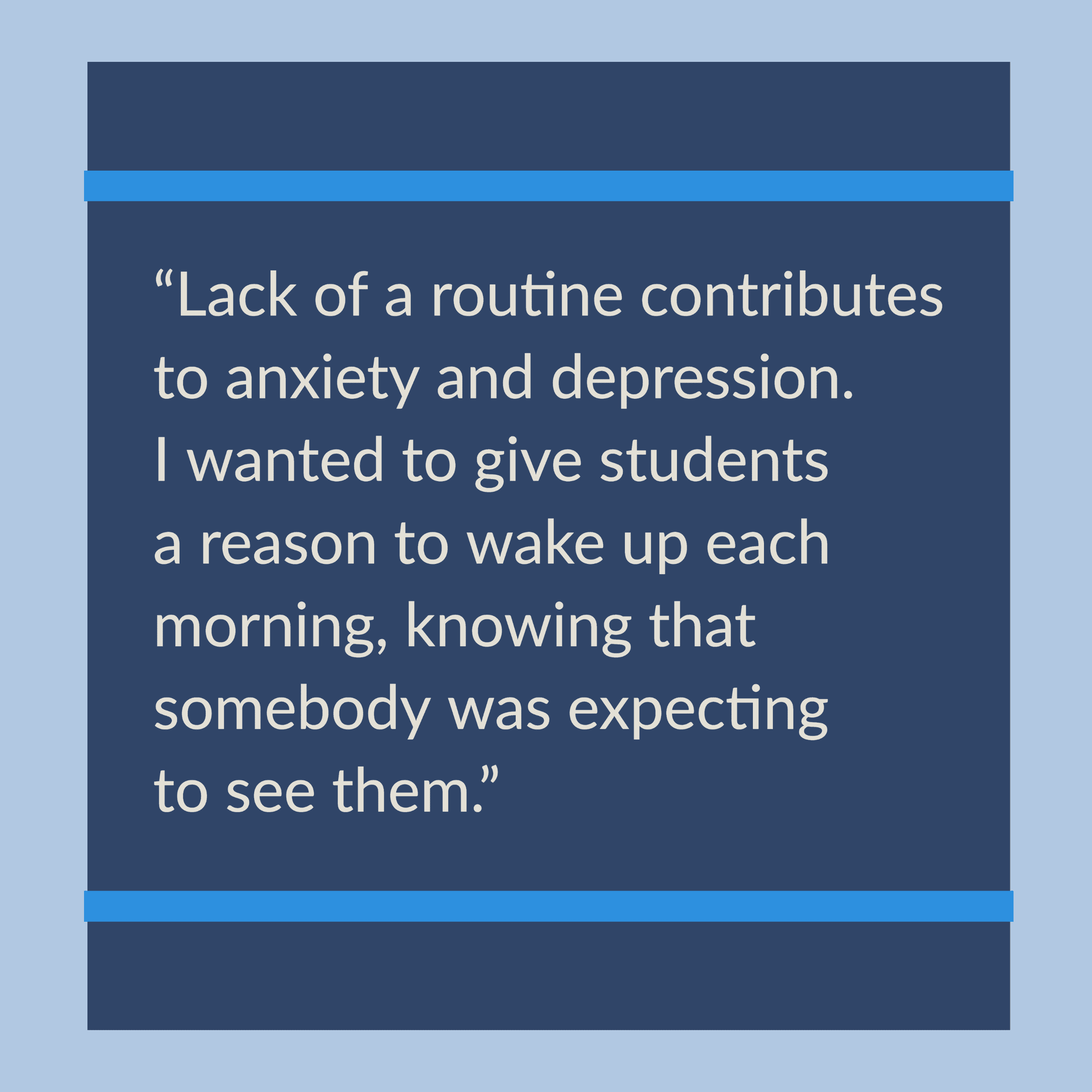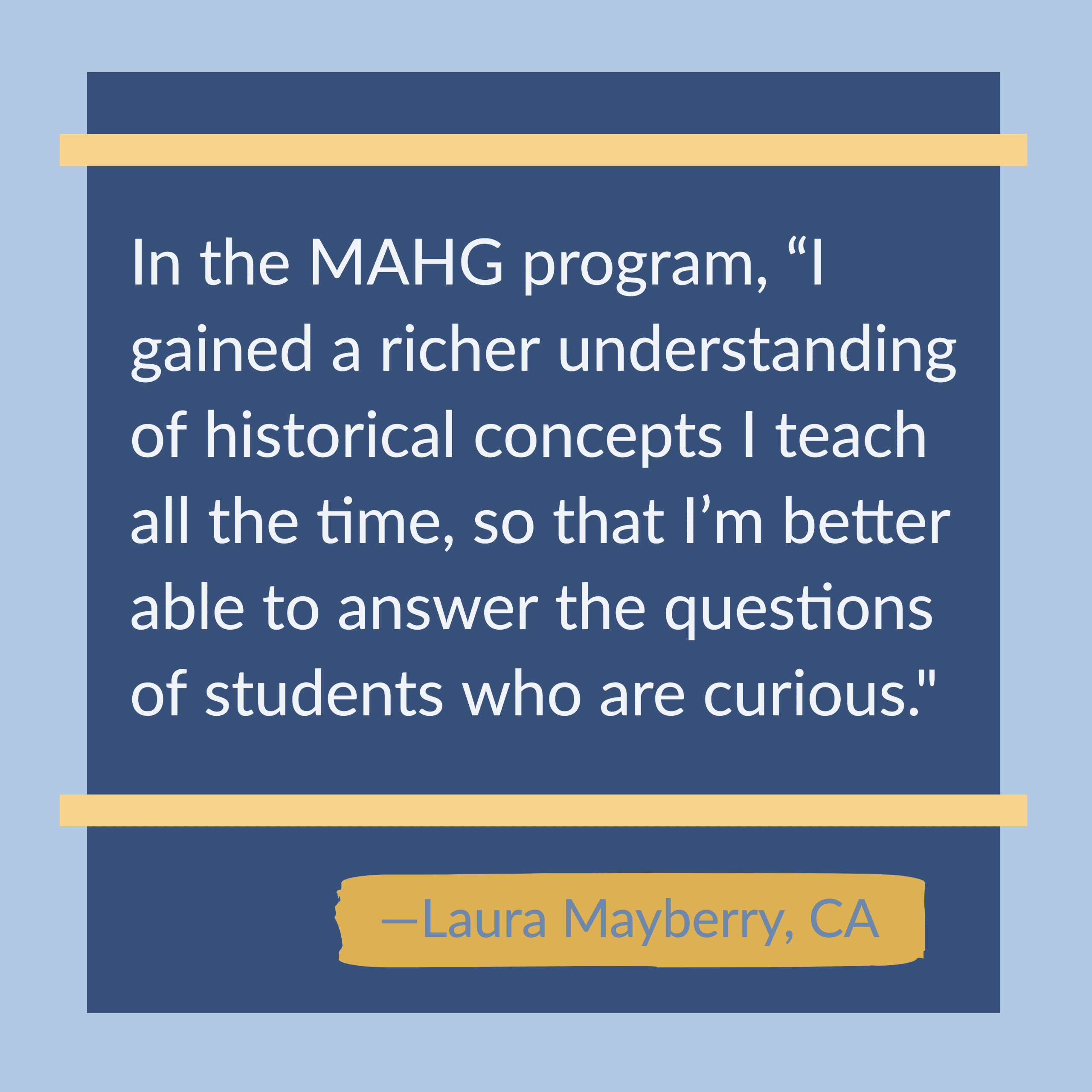Meet Our Teachers
Laura Mayberry

Meeting Academic and Psychological Needs During the Pandemic
When the pandemic forced high school instruction online last March, school administrators cut back on teacher/student contact hours. With many schools relying on Zoom, and every teacher needing the platform, administrators typically allotted time for only one or two weekly class meetings per course section. Yet teachers felt busier than ever. Preparing lessons and assignments for online delivery took extra time.
Laura Mayberry, who teaches at Corona Del Mar High School in Newport Beach, California, felt better prepared for the transition to online teaching than many of her colleagues. The online courses she took as a student in Teaching American History’s Master’s program familiarized her with interactive learning from both students’ and teachers’ perspectives. “The WebEx system we use in MAHG is very similar to the Zoom system I’m using with students,” Mayberry said. “I had even led an online class, since my professor for American Foreign Policy, Eric Pullen, assigned presentations. I’d seen how the hand raising icon works.”
As California’s shelter in place order became likely, Mayberry reassured her students. “They asked, ‘Will we still have class?’ I said, ‘Oh sure, business as usual. I will see you online.’ So, when the SIP was ordered, my kids were like, ‘when do we log on? What time?’”
Maintaining the Routine
Mayberry could maintain “business as usual” to a greater degree than most teachers. In her affluent school district, students have access to computers and internet. Also, “my school has the technology to support daily online class meetings for all course sections,” she said. “I taught bell to bell, every period, every single day. I felt that if I did not, I would lose the connection with my students, and it would be hard to recapture that.” Maintaining the connection, she could better meet students’ academic and psychological needs.
 Because all the courses Mayberry teaches are Advanced Placement, “I felt a real responsibility to get students ready for the AP exams.” Mayberry founded and directs the Academy of Global Studies at Corona Del Mar. It helps students “understand other nations and societies and . . . deal with the economic, political, social, cultural and security issues confronting the world today.” The program combines a comparative approach to social studies and literature with language study and intensive research projects. Within the academy, Mayberry teaches AP courses in US history, comparative government and politics, and macroeconomics, along with sophomore and junior-level AP research courses leading to a capstone project.
Because all the courses Mayberry teaches are Advanced Placement, “I felt a real responsibility to get students ready for the AP exams.” Mayberry founded and directs the Academy of Global Studies at Corona Del Mar. It helps students “understand other nations and societies and . . . deal with the economic, political, social, cultural and security issues confronting the world today.” The program combines a comparative approach to social studies and literature with language study and intensive research projects. Within the academy, Mayberry teaches AP courses in US history, comparative government and politics, and macroeconomics, along with sophomore and junior-level AP research courses leading to a capstone project.
The sole social studies teacher for sophomores, juniors and seniors in the rigorous program, Mayberry builds friendly bonds with students. Students “either like me, or learn to like me,” she said. “I tell them, I’ll grow on you like mold!”
Mayberry worried about the toll distanced learning would take on students’ mental health. “Students need to feel a connection to their school and to each other,” she said. Also, lack of a routine contributes to anxiety and depression. “I wanted to give students a reason to wake up each morning, knowing that somebody was expecting to see them. Many of my students are seniors I’ve had in class for several years, so their emotional health weighs on me. I wanted them to know that I like seeing them every day.”
Teaching the Whole Student
Mayberry has always made herself available to students. “In live teaching, I teach before school, during break, at lunch, and after school. My kids come in early, tell me about their day, ask questions, and hang out.” She gets to know students’ “sports, siblings, what they like to do in their free time, how funny they are.” This knowledge helped her after distanced learning began.
In the physical classroom, “teachers watch students’ body language as they walk into class and take a seat, slumping or sitting up attentively. They note whether a student is engaging the way they normally would.” Online, “it takes more effort to learn how students are doing.”
She talked with students as she admitted them one by one to Zoom meetings. “Having learned about their lives before we went online, I could ask questions about their interests. I might start a low-pressure conversation before the main part of class begins, asking, ‘What have you been doing to keep yourself occupied during quarantine?’ This gets students talking to each other about TV programs they’ve watched, and loosens them up to discuss the assignment.
“My largest class had 38 students; my smallest 21. In the larger class, I couldn’t see all my students in the same window.” Fortunately, “that class was well trained to engage in organic discussions.” Yet adjustments were needed. “In an exciting discussion, kids jump in and interrupt each other. Online, talking over each other creates sound distortions, so students muted themselves to be respectful, causing hesitations.” At times she broke her own rule against putting students on the spot. “I might say, ‘Katie, what are you thinking about this?’”
Building Skills and Nurturing Curiosity
As a MAHG student, Mayberry “really enjoyed” her online courses. “Teachers brought academic curiosity to the class sessions. We came looking to learn things and wanting to talk with our professors. The professors didn’t mind if we emailed them extra questions, so we did. But high school students’ academic curiosity has not necessarily matured. They may think history or government is not their subject; but listening to the stories of history, they get curious.” To nurture that curiosity, Mayberry needed to meet with students online every school day.
“It’s more work,” she admitted. She spent evenings and weekends getting assignments onto the online platform. But when she asked for feedback, her students thanked her. “I asked them, ‘what is the hardest thing about online school?’ They replied, ‘Our teachers don’t connect with us as often as before; some of them dump the whole week’s assignments on us on Monday.’ They’re still learning to budget their time.” One student complained, “I knew what I had to do this week, but when I got to Wednesday’s assignment, I had a lot of questions which I couldn’t ask, because my teacher’s office hours had happened on Tuesday.” Following the usual daily schedule “keeps students focused—and not so lonely,” Mayberry said.
Maintaining classroom rituals also helps. On test days, Mayberry always played recorded “pump-up music” (usually “stadium anthems like ‘Eye of the Tiger’”) as students walked into class, put books away, and found their pens and pencils. She introduced a similar ritual for the several minutes it takes to funnel students from the Zoom wait room to the classroom. Finding a magazine article suggesting twenty songs “to play first thing in the morning for a fabulous day,” she decided to play one song a day for four weeks. She explained to students, “After we’ve heard them all, we’ll decide which other songs should be added to the list.”
Mental Health Supports Learning, and Vice Versa
Taking time to maintain relationships and encourage positive attitudes seems inefficient. Yet it minimizes students’ anxiety, allowing Mayberry to maintain academic rigor. “Sometimes, instead of thinking of all the ways we could make distanced learning work, we’re inclined to give up. ‘Oh, let’s just do pass/fail’ or ‘let’s just give enrichment activities.’ By the time we get back to a regular classroom, how long will it have been since they were really learning? What will they have missed and need to make up?”
History study itself can reduce students’ anxiety, since the past helps us make sense of the present. Mayberry’s study of US history in MAHG helped her guide students in drawing historical connections. “We can talk about other pandemics—like the flu pandemic of 1918—and about emergencies like the Great Depression.” When students in her APUSH class asked about gubernatorial powers to manage crises, Mayberry seized the teachable moment. “Interesting you should ask,” she said. “Remember what we learned about federalism?” When students asked about presidential responsibilities during emergencies, Mayberry recalled both the New Deal and the civil rights era. “Eisenhower’s use of the National Guard to get African American students into Little Rock High challenged some people’s idea of federalism.”
Teaching American History helps teachers like Mayberry make the lessons of history available to new generations. “MAHG reaffirmed how much I love history and how much I still have to learn,” Mayberry said. “I gained a richer understanding of historical concepts I teach all the time, so that I’m better able to answer the questions of students who are curious. I met new colleagues to collaborate with. All these things, plus MAHG’s hybrid structure—part online and part in-person—have made this uncertain time of pandemic so much more manageable.”
